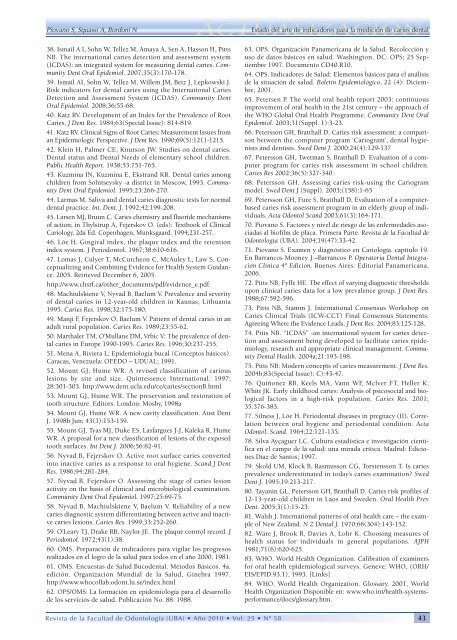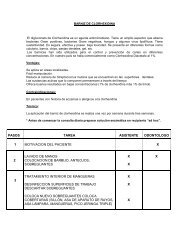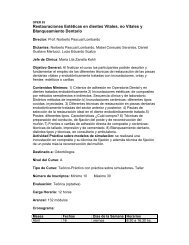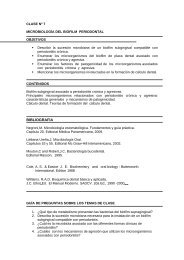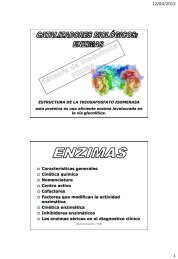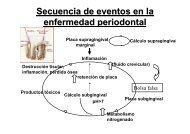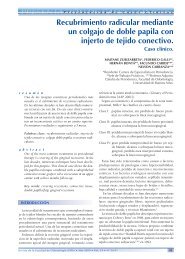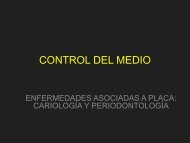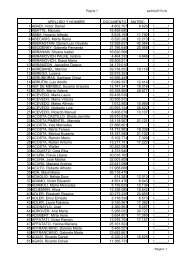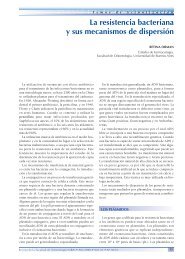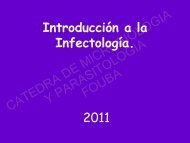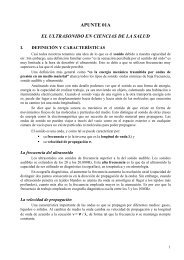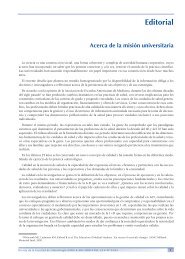Estado del arte de indicadores para la medición de caries dental
Estado del arte de indicadores para la medición de caries dental
Estado del arte de indicadores para la medición de caries dental
- No tags were found...
You also want an ePaper? Increase the reach of your titles
YUMPU automatically turns print PDFs into web optimized ePapers that Google loves.
Piovano S, Squassi A, Bordoni N38. Ismail A I, Sohn W, Tellez M, Amaya A, Sen A, Hasson H, PittsNB. The international <strong>caries</strong> <strong>de</strong>tection and assessment system(ICDAS): an integrated system for measuring <strong>de</strong>ntal <strong>caries</strong>. CommunityDent Oral Epi<strong>de</strong>miol. 2007;35(3):170-178.39. Ismail AI, Sohn W, Tellez M, Willem JM, Betz J, Lepkowski J.Risk indicators for <strong>de</strong>ntal <strong>caries</strong> using the International CariesDetection and Assessment System (ICDAS). Community DentOral Epi<strong>de</strong>miol. 2008;36:55-68.40. Katz RV. Development of an In<strong>de</strong>x for the Prevalence of RootCaries, J Dent Res. 1984;63(Special Issue): 814-819.41. Katz RV. Clinical Signs of Root Caries: Measurement Issues froman Epi<strong>de</strong>miologic Perspective. J Dent Res. 1990;69(5):1211-1215.42. Klein H, Palmer CE, Knutson JW. Studies on <strong>de</strong>ntal <strong>caries</strong>.Dental status and Dental Needs of elementary school children.Public Health Report. 1938;53:751-765.43. Kuzmina IN, Kuzmina E, Ekstrand KR. Dental <strong>caries</strong> amongchildren from Solntseysky -a district in Moscow, 1993. CommunityDent Oral Epi<strong>de</strong>miol. 1995;23:266-270.44. Larmas M. Saliva and <strong>de</strong>ntal <strong>caries</strong> diagnostic tests for normal<strong>de</strong>ntal practice. Int. Dent. J. 1992;42:199-208.45. Larsen MJ, Bruun C. Caries chemistry and fluori<strong>de</strong> mechanismsof action; in Thylstrup A, Fejerskov O. (eds): Textbook of ClinicalCariology, 2da Ed. Copenhagen, Munksgaard. 1994;231-257.46. Löe H. Gingival in<strong>de</strong>x, the p<strong>la</strong>que in<strong>de</strong>x and the retentionin<strong>de</strong>x system. J Periodontol. 1967;38:610-616.47. Lomas J, Culyer T, McCutcheon C, McAuley L, Law S. Conceptualizingand Combining Evi<strong>de</strong>nce for Health System Guidance.2005. Retrieved December 6, 2005.http://www.chsrf.ca/other_documents/pdf/evi<strong>de</strong>nce_e.pdf.48. Machiulskiene V, Nyvad B, Baelum V. Prevalence and severityof <strong>de</strong>ntal <strong>caries</strong> in 12-year-old children in Kaunas, Lithuania1995. Caries Res. 1998;32:175-180.49. Manji F, Fejerskov O, Baelum V. Pattern of <strong>de</strong>ntal <strong>caries</strong> in anadult rural popu<strong>la</strong>tion. Caries Res. 1989;23:55-62.50. Marthaler TM, O’Mul<strong>la</strong>ne DM, Vrbic V: The prevalence of <strong>de</strong>ntal<strong>caries</strong> in Europe 1990-1995. Caries Res. 1996;30:237-255.51. Mena A, Riviera L: Epi<strong>de</strong>miología bucal (Conceptos básicos).Caracas, Venezue<strong>la</strong>: OFEDO – UDUAL; 1991.52. Mount GJ, Hume WR. A revised c<strong>la</strong>ssification of cariouslesions by site and size. Quintessence International. 1997;28:301-303. http://www.<strong>de</strong>nt.uc<strong>la</strong>.edu/ce/<strong>caries</strong>/sectionB.html53. Mount GJ, Hume WR. The preservation and restoration oftooth structure. Editors. London: Mosby, 1998a54. Mount GJ, Hume WR. A new cavity c<strong>la</strong>ssification. Aust DentJ. 1998b Jun; 43(3):153-159.55. Mount GJ, Tyas MJ, Duke ES, Lasfargues J-J, Kaleka R, HumeWR. A proposal for a new c<strong>la</strong>ssification of lesions of the exposedtooth surfaces. Int Dent J. 2006;56:82-91.56. Nyvad B, Fejerskov O. Active root surface <strong>caries</strong> convertedinto inactive <strong>caries</strong> as a response to oral hygiene. Scand J DentRes. 1986;94:281-284.57. Nyvad B, Fejerskov O. Assessing the stage of <strong>caries</strong> lesionactivity on the basis of clinical and microbiological examination.Community Dent Oral Epi<strong>de</strong>miol. 1997;25:69-75.58. Nyvad B, Machiulskiene V, Baelum V. Reliability of a new<strong>caries</strong> diagnostic system differentiating between active and inactive<strong>caries</strong> lesions. Caries Res. 1999;33:252-260.59. O’Leary TJ, Drake RB, Naylor JE. The p<strong>la</strong>que control record. JPeriodontol. 1972;43(1):38.60. OMS. Pre<strong>para</strong>ción <strong>de</strong> <strong>indicadores</strong> <strong>para</strong> vigi<strong>la</strong>r los progresosrealizados en el logro <strong>de</strong> <strong>la</strong> salud <strong>para</strong> todos en el año 2000, 1981.61. OMS. Encuestas <strong>de</strong> Salud Buco<strong>de</strong>ntal. Métodos Básicos. 4a.edición. Organización Mundial <strong>de</strong> <strong>la</strong> Salud, Ginebra 1997.http://www.whocol<strong>la</strong>b.odont.lu.se/in<strong>de</strong>x.html62. OPS/OMS: La formación en epi<strong>de</strong>miología <strong>para</strong> el <strong>de</strong>sarrollo<strong>de</strong> los servicios <strong>de</strong> salud. Publicación No. 88. 1988.<strong>Estado</strong> <strong><strong>de</strong>l</strong> <strong>arte</strong> <strong>de</strong> <strong>indicadores</strong> <strong>para</strong> <strong>la</strong> medición <strong>de</strong> <strong>caries</strong> <strong>de</strong>ntal63. OPS. Organización Panamericana <strong>de</strong> <strong>la</strong> Salud. Recolección yuso <strong>de</strong> datos básicos en salud. Washington, DC: OPS; 25 Septiembre1997. Documento CD40.R10.64. OPS. Indicadores <strong>de</strong> Salud: Elementos básicos <strong>para</strong> el análisis<strong>de</strong> <strong>la</strong> situación <strong>de</strong> salud. Boletín Epi<strong>de</strong>miológico, 22 (4): Diciembre,2001.65. Petersen P. The world oral health report 2003: continuousimprovement of oral health in the 21st century – the approach ofthe WHO Global Oral Health Programme. Community Dent OralEpi<strong>de</strong>miol. 2003;31(Suppl. 1):3-23.66. Petersson GH, Bratthall D. Caries risk assessment: a comparisonbetween the computer program ‘Cariogram’, <strong>de</strong>ntal hygienistsand <strong>de</strong>ntists. Swed Dent J. 2000;24(4):129-13767. Petersson GH, Twetman S, Bratthall D. Evaluation of a computerprogram for <strong>caries</strong> risk assessment in school children.Caries Res 2002;36(5):327-340.68. Petersson GH. Assessing <strong>caries</strong> risk-using the Cariogrammo<strong><strong>de</strong>l</strong>. Swed Dent J (Suppl). 2003;(158):1-6569. Petersson GH, Fure S, Bratthall D. Evaluation of a computerbased<strong>caries</strong> risk assessment program in an el<strong>de</strong>rly group of individuals.Acta Odontol Scand 2003;61(3):164-171.70. Piovano S. Factores y nivel <strong>de</strong> riesgo <strong>de</strong> <strong>la</strong>s enfermeda<strong>de</strong>s asociadasal biofilm <strong>de</strong> p<strong>la</strong>ca. Primera P<strong>arte</strong>. Revista <strong>de</strong> <strong>la</strong> Facultad <strong>de</strong>Odontología (UBA). 2004;19(47):33-42.71. Piovano S. Examen y diagnóstico en Cariología. capítulo 19.En Barrancos Mooney J –Barrancos P. Operatoria Dental IntegraciónClínica 4º Edición. Buenos Aires: Editorial Panamericana,2006.72. Pitts NB, Fyffe HE. Tbe effect of varying diagnostic thresholdsupon clinical <strong>caries</strong> data for a low prevalence group. J Dent Res.1988;67:592-596.73. Pitts NB, Stamm J. International Consensus Workshop onCaries Clinical Trials (ICW-CCT) Final Consensus Statements:Agreeing Where the Evi<strong>de</strong>nce Leads. J Dent Res. 2004;83:125-128.74. Pitts NB. “ICDAS” -an international system for <strong>caries</strong> <strong>de</strong>tectionand assessment being <strong>de</strong>veloped to facilitate <strong>caries</strong> epi<strong>de</strong>miology,research and appropriate clinical management. CommunityDental Health. 2004a;21:193-198.75. Pitts NB: Mo<strong>de</strong>rn concepts of <strong>caries</strong> measurement. J Dent Res.2004b;83(Special Issue): C):43-47.76. Quiñonez RB, Keels MA, Vann WF, Mclver FT, Heller K,Whitt JK. Early childhood <strong>caries</strong>: Analysis of psicosocial and biologicalfactors in a high-risk popu<strong>la</strong>tion. Caries Res. 2001;35:376-383.77. Silness J, Löe H. Periodontal diseases in pregnacy (II). Corre<strong>la</strong>tionbetween oral hygiene and periodontal condition. ActaOdontol. Scand. 1964;22:121-135.78. Silva Ayçaguer LC. Cultura estadística e investigación científicaen el campo <strong>de</strong> <strong>la</strong> salud: una mirada crítica. Madrid: EdicionesDíaz <strong>de</strong> Santos; 1997.79. Skold UM, Klock B, Rasmusson CG, Torstensson T. Is <strong>caries</strong>prevalence un<strong>de</strong>restimated in today’s <strong>caries</strong> examination? SwedDent J. 1995;19:213-217.80. Tayanin GL, Petersson GH, Bratthall D. Caries risk profiles of12-13-year-old children in Laos and Swe<strong>de</strong>n. Oral Health PrevDent. 2005;3(1):15-23.81. Walsh J. International patterns of oral health care – the exampleof New Zea<strong>la</strong>nd. N Z Dental J. 1970;66(304):143-152.82. Ware J, Brook R, Davies A, Lohr K. Choosing measures ofhealth status for individuals in general popu<strong>la</strong>tions. AJPH1981;71(6):620-625.83. WHO. World Health Organization. Calibration of examinersfor oral health epi<strong>de</strong>miological surveys. Geneve: WHO, (ORH/EIS/EPID.93.1), 1993. [Links]84. WHO. World Health Organization. Glossary. 2001, WorldHealth Organization Disponible en: www.who.int/health-systemsperformance/docs/glossary.htm.Revista <strong>de</strong> <strong>la</strong> Facultad <strong>de</strong> Odontología (UBA) • Año 2010 • Vol. 25 • Nº 5843


